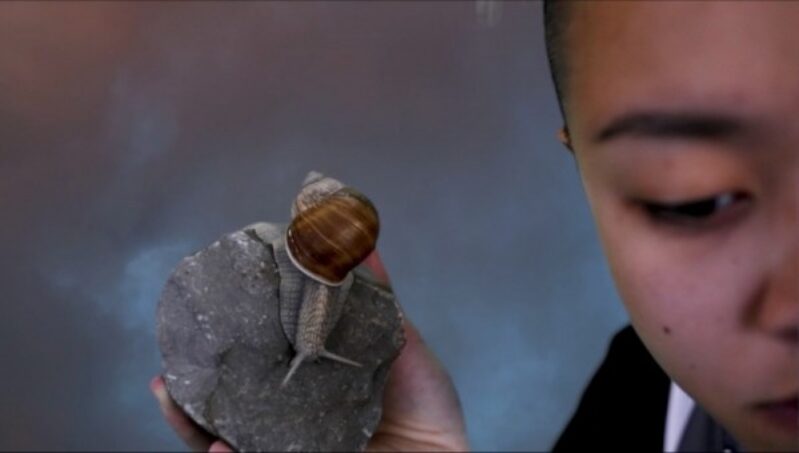Challenging Viewers in a New Way
Written by Eleanor C, during TeenTix’s arts criticism training workshop, the Fall 2018 Press Corps Intensive.

Art has one true purpose, to evoke feeling, to cause a reaction within someone.
The enigmatic art exhibit entitled "Between Bodies" conjures up complex, even contradictory, responses. At times the immersive installations made me feel as if I was both in our recognizable world and beyond it, leading me to reconsider ideas about representation, humanity, and the environment.
The exhibition, currently at the Henry Art Gallery, centers around queer and questioning artists sharing their unique perspectives on climate change and the environmental impacts of humans. There were six installations by eight artists, who used a variety of media, including, as stated in the press release, “sculpture, sound and video, and augmented reality.” This exhibit is especially relevant during a time of political turmoil, racial violence, rising water levels, dwindling species, and increasing temperatures and many more environmental impacts.
Carolina Caycedo’s enigmatic "Water Portraits" – long tapestries covered in pictures of bodies of water – fill a spacious room. These large strips of canvas hang from the wall, drip on the ground and interact with the space in an impactful way. The shapes and shadows that were created seem both deliberate and unintentional, as there is no symmetry or pattern. Each tapestry was covered in one image of water, continually repeating. Before getting closer to the art, you don't have much of an idea of what the image is or signifies; you are free to make your assumptions about what the image is, much like an inkblot. Moving closer, you can see the waves crashing, the white froth that rises to the top of the surface, making it unmistakably water. Caycedo chose a variety of colors to lay over the water, hues of pink and green and blue and grey. The waves seemed angry. It was not a peaceful piece. The blend of her soft and flowy medium combined with chaotic water was impactful and invited us to think about how we perceive the forms and movements of the natural world.
Caycedo is an activist and artist, and uses her medium to communicate the “impacts large dams have on populations and landscapes across Latin America” as relayed in her artist statement. Being in close proximity with these large tapestries makes one hyper aware of their size, much like being inside a body of water.

micha cárdenas (U.S., born 1977) and Abraham Avnisan (U.S., born 1983). Sin Sol, Forest Memory 4. 2018. Digital image of LIDAR scan. Image courtesy of the artists.
In contrast to Caycedo’s light and airy gallery, the installation, titled "Sin Sol," by Abraham Avnian’s and micha cárdenas, immerses us in a video and audio sensory experience. Upon entering the room you see a projection of a forest on the walls. As you approach you notice the pixelation of the projection, interfering with the image of nature you first saw. What you now see is something man made. The idea of a man made world feels somewhat sinister and apocalyptic, although the welcoming feel of the installation did not at first give that intention.
Two iPad’s hanging down from the ceiling offered another layer to the piece. On the screens are poems about the changing of the world and the environmental impact of humans written in past and future perspectives in a world “blanketed by forest fires”. In this future, the human race has been wiped clean by itself, following violence against marginalized groups like trans, Latinx, and immigrants.
In the background of all of this, you heard a man’s and woman's voice recite these poems accompanied by echoed sound, fully engulfing me in the whole experience. The poetic stories, the augmented reality avatars, and the surrounding visual and auditory experience all work together to guide us through new worlds, all with different realities.

Teens from the Press Corps Intensive at "Between Bodies" at Henry Art Gallery
"Between Bodies" was a strange but impactful experience which I found valuable in the end. The use of mixed media and the use of not just visuals and sound, but touch and feeling, was unique. I moved through this exhibit softly, and cautiously, not in a bad way, but because I was extremely aware of the spaces around me and my own body. At the same time, I almost forgot about my own life and my memories and experiences for a short while. The exhibit made me lose my preconceptions and erased my biases. This was extremely significant because if an art exhibit can make you feel almost lost within yourself, that is amazing.
Representation in art is massively important. Art is the form in which we express our emotions, tell our stories and release our inhibitions. If artists are not given the opportunities to show their work with the world, we as a society cannot expand our minds and learn from others. "Between Bodies" represented queer artists who offer under examined perspectives on climate change, making the exhibit important for the growth of humanity.
Art will never be a bad thing to experience, and all art provokes one to ponder. "Between Bodies" challenges viewers in a new way, to think about what they can do to help the world, instead of relying on others for the solutions. This art exhibit opens up alternative, speculative, and empathetic lenses through which to glimpse the interconnectedness of humans and other bodies.
This review was written as part of the Fall 2018 Press Corps Intensive. It was edited by teaching artist and critic Gayle Clemans.
The TeenTix Press Corps promotes critical thinking, communication, and information literacy through criticism and journalism practice for teens. For more information about other Press Corps programs including the Teen Editorial Staff or the TeenTix Newsroom, see HERE.


